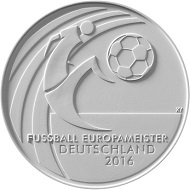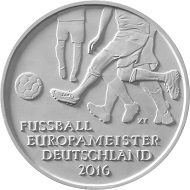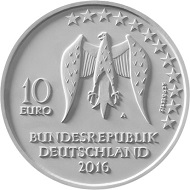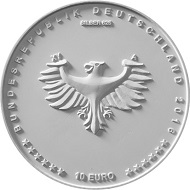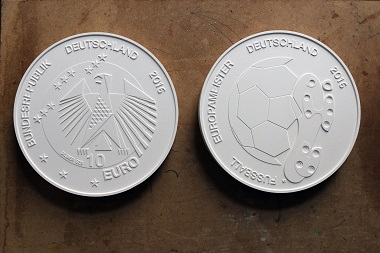by numiscontrol
June 21, 2018 – We are almost there and many hearts will be beating faster when the fight for the leather ball begins. For months there have been speculations about how the German team will do this time. The stores are filled with merchandise and many a honorable man buys a precautionary “Black-Red-Gold” make-up kit. TV sets shall be installed in offices, cars are being washed and decked with flags. Everything is in the pipeline!
Maybe secret preparations also have been done long since in another area – in the area of coin issue. Already for the European championship 2016, the question was extensively dealt with: What happens if Germany wins?
The first prize went to a design by Isabel James, Staatliche Zeichenakademie Hanau. Photographer: Hans-Joachim Wuthenow, Berlin. Source: BADV.
A high-level jury chooses the winning design
In late fall 2015, a jury met in Berlin behind closed doors, since only very few were informed. The jury consisted of two sculptors, representatives of the Federal Office for Central Services and Unresolved Property Issues (BADV) and the Federal Ministry of Finance (BMF) as well as the CEO of a Berlin soccer team. The numismatic representative was a leading expert from the Münzkabinett Berlin. The jury was supported by a surveyor, who, at the same time, was the CEO of a German mint. Another representative of the BADV was invited as a guest. Two representatives of the BADV took care of the planning and realization of the event.
Acquisition of emerging artists
Beforehand, the BADV had announced a coin competition for art funding, which became of great importance for the acquisition of emerging artists for the German coin competitions. All participants who were elected by the jury, were included in the artist file and the winners were even considered for one of the following invitation competitions. So it is written in the report of the event. All nineteen artists who were invited to the event, were students from different art schools all over Germany. In total, 40 works were preevaluated. Graphic designs and plaster models of the obverse and reverse of a coin in white, hard plaster in a little over five times the original size were required. But what was the theme?
Alexander Leschinez, Akademie der Bildenden Künste Nürnberg earned the second place in the competition. Photographer: Hans-Joachim Wuthenow, Berlin. Source: BADV.
The special 10 euro coin for 2016
The theme was late-breaking: What would a coin look like that could be issused by Germany in case the German team wins the European championship? To actually issue such a coin was explicitly not the plan, as emphazised by the BADV.
It should be a soccer motif with great significance and dynamics. The national side should also be designed accordingly. As ususal, the federal eagle should have a dignified form, although the overall design here should also be in accordance with the motif on the obverse. The designs should be submitted mid-November 2015. After that, all works were unpacked, concealed and preevaluated.
Melissa Glanz, Hochschule für Gestaltung Niederrhein, Krefeld earned the third place. Photographer: Hans-Joachim Wuthenow, Berlin. Source: BADV.
The jury in session
Every preevaluated design was presented to the jury under a concealing number, so that they could not relate it to any particular artist. The works were presented individually and were extensively discussed. The jury praised the overall high quality of almost all the presented works. In the first evaluation viewing, all works that got at least one affirmative vote should remain in the running, after that, a simple majority of votes was required.
In the first evaluation viewing, two designs were dismissed, in the second eight others. In the third viewing, four of the ten works remained. Those were compared and extensively discussed in the fourth viewing.
The design by Sebastian Siechold, Berlin, was dismissed in the fourth viewing, but still bought up and published along with the three winning designs due to its quality. Photo: Sebastian Siechold. Source: BADV.
In the end, another design was dismissed but still published along with the three winning designs by unanimous decision of the jury.
Then followed the vote for the three winning positions. The winners were awarded a prize money. In addition to the winning designs, six further designs from all the submitted works were bought up due to their high artisanal quality. The respective artists were included in the artist file. The jury advised unanimously that the winning artists shall be invited to one of the regular competitions.
“What if?” 2018
The German national soccer team did not win the European championship 2016 and the competition remained a business game. Naturally, that is sad for soccer fans and coin collectors. But as the saying goes: “New game, new luck!”
The soccer world cup is about to start and the German team seems to be very fit. Who knows, maybe there was a secret competition to design a coin in case they win?
Let us take potluck and keep our fingers crossed for the German team! A world title could also make numismatists happy. After all, it could imply coined silver!
For the soccer world cup 2014, Degussa minted silvermedals with soccer heroes of the German history of sports, the Münze Berlin honored the European women’s soccer in 2017.
In 2011, Germany issued a 10 euro coin for the women’s soccer world cup in Germany.
Künker offered, as part of a collection of German patterns and double strikes at its summer auction 2018, an extraordinary pattern of this commemorative coin for the women’s soccer world cup 2011.
Nowadays, athletic success does not decide between life and death of the players anymore. In ancient Mexico, the situation was completely different, as you can read in this article about ball games in ancient Mexico.
And if you wish to get up to date on the ranking of the German national soccer team (or any one you like better), you can look it up on the official FIFA website for the world cup 2018.





